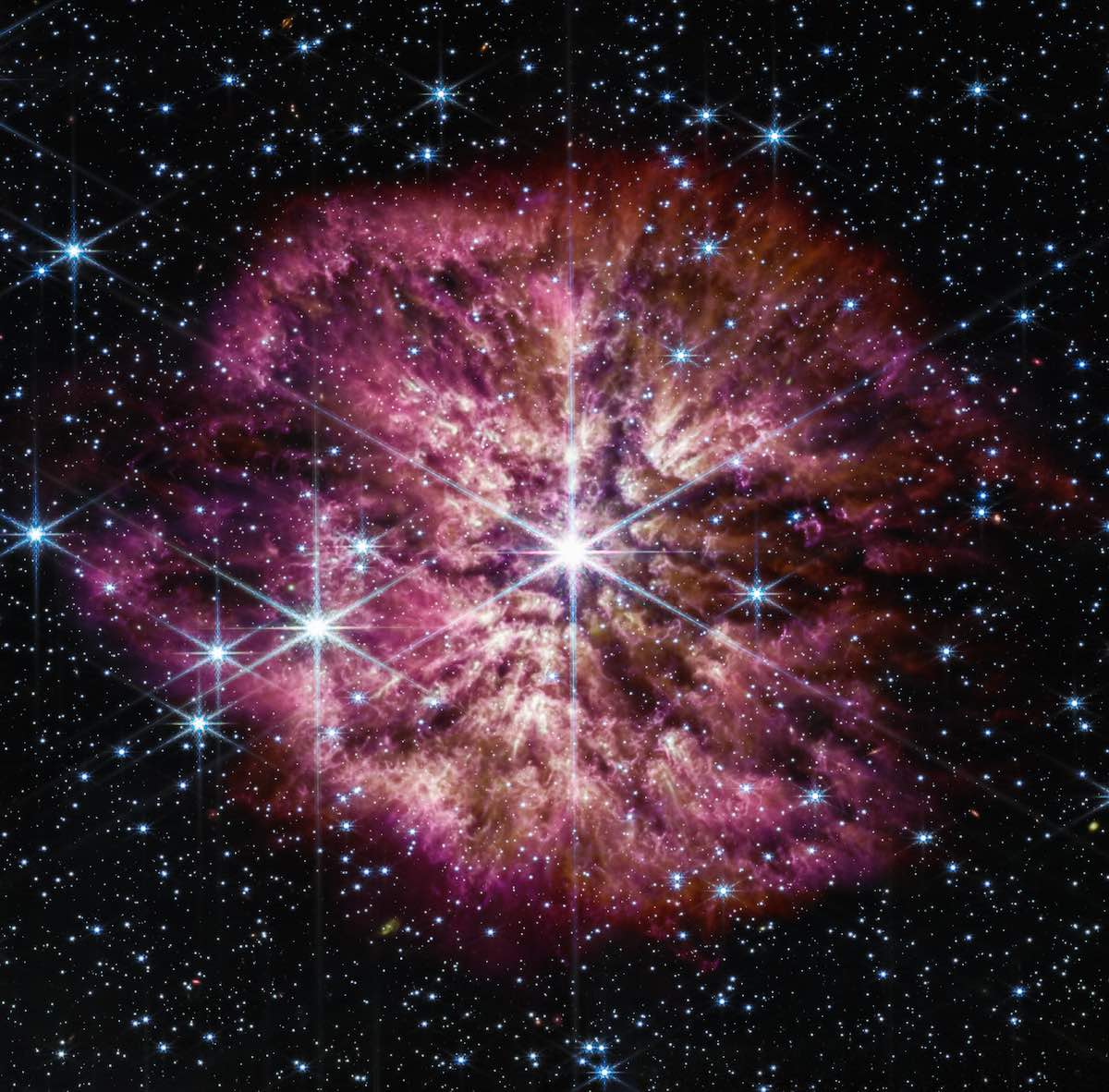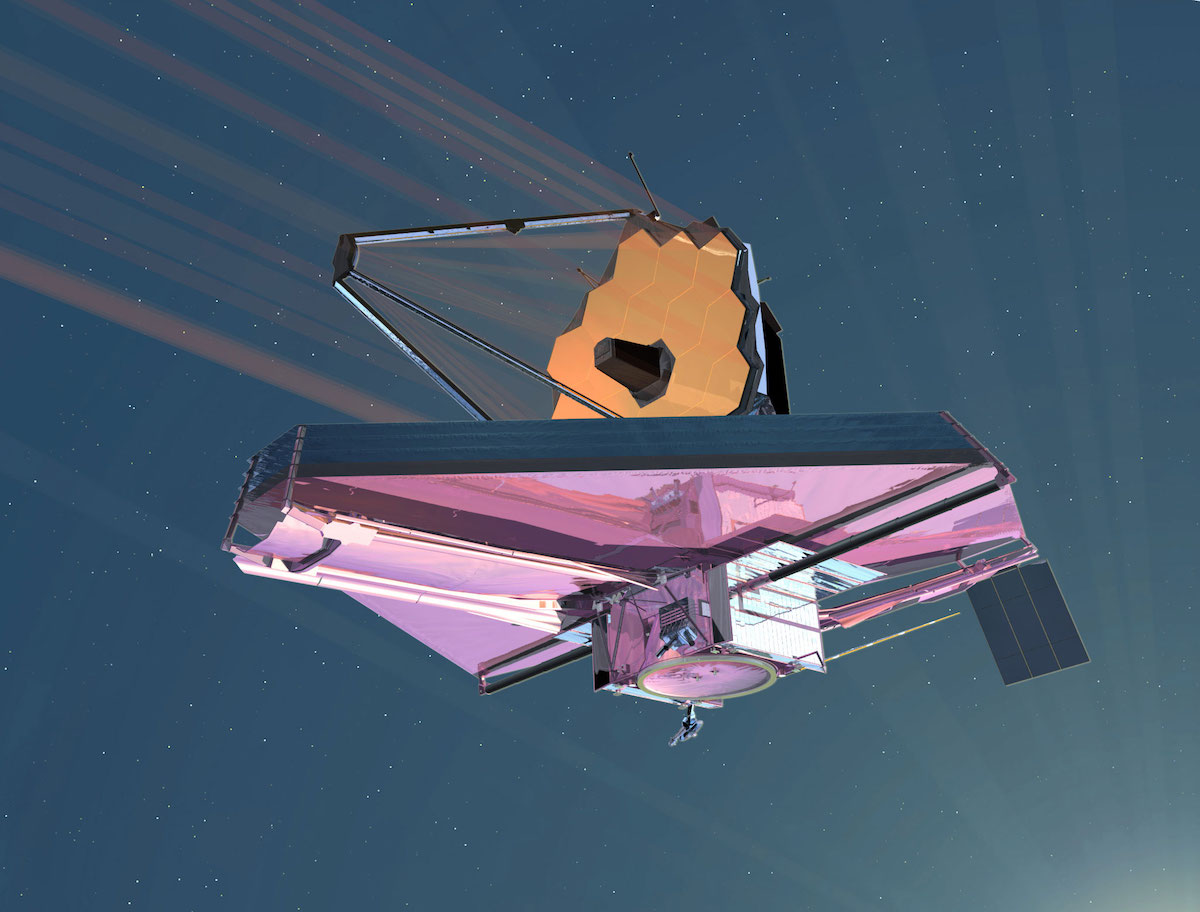Space News & Blog Articles
Webb telescope sees the prelude to a supernova
 The luminous, hot star Wolf-Rayet 124 (WR 124) is prominent at the center of the James Webb Space Telescope’s composite image combining near-infrared and mid-infrared wavelengths of light from Webb’s Near-Infrared Camera and Mid-Infrared Instrument. Credits: NASA, ESA, CSA, STScI, Webb ERO Production Team
The luminous, hot star Wolf-Rayet 124 (WR 124) is prominent at the center of the James Webb Space Telescope’s composite image combining near-infrared and mid-infrared wavelengths of light from Webb’s Near-Infrared Camera and Mid-Infrared Instrument. Credits: NASA, ESA, CSA, STScI, Webb ERO Production Team
A new image from the James Webb Space Telescope shows a rare glimpse of a massive star 15,000 light-years away shedding a halo of gas and dust, seeding the cosmos with elements necessary for forming other stars, planets, and the building blocks of life.
The colorful vista captured by the Webb telescope combines observations from the observatory’s instruments sensitive to different wavelengths of light in the near-infrared and mid-infrared portion of the spectrum. It shows a Wolf-Rayet star, a class of extremely hot, luminous stars that eject gargantuan amounts of gas and dust from their outer layers before ending their lives in a supernova explosion.
Webb’s view of a star known as WR 124, located in the constellation Sagitta, shows a cloud of gas cooling as it streams away into interstellar space, the void between the stars. Webb’s infrared instruments are able to detect the thermal emissions from the gas and dust, material that is difficult to see with observatories seeing visible light.
The glowing cloud of gas and dust surrounding WR 124 spans 10 light-years across.
“A history of the star’s past episodes of mass can be read in the nebula’s structure,” officials from the Space Telescope Science Institute, which operates Webb, wrote in a press release. “Rather than smooth shells, the nebula is formed from random, asymmetric ejections. Bright clumps of gas and dust appear like tadpoles swimming toward the star, with tails streaming out behind them, blown back by the stellar wind. ”
The star is 30 times the mass of the sun, and has shed material equivalent to 10 suns, according to NASA. Stars of that size can burn through their fuel in just a few hundred thousands years, a tiny fraction of the roughly 10 billion-year life span of a star like the sun.
Not all massive stars become Wolf-Rayet stars. Those that do blast material into space that can later become the molecules that help create new stars and planets.
“The origin of cosmic dust that can survive a supernova blast and contribute to the universe’s overall ‘dust budget’ is of great interest to astronomers for multiple reasons,” officials wrote in a NASA press release accompanying the new Webb image. “Dust is integral to the workings of the universe: It shelters forming stars, gathers together to help form planets, and serves as a platform for molecules to form and clump together — including the building blocks of life on Earth.
“Despite the many essential roles that dust plays, there is still more dust in the universe than astronomers’ current dust-formation theories can explain. The universe is operating with a dust budget surplus,” NASA said.
 Artist’s illustration of the fully deployed James Webb Space Telescope. Credit: NASA
Artist’s illustration of the fully deployed James Webb Space Telescope. Credit: NASA
Webb’s huge size and sensitive instruments should yield new insights into how dust is created in the universe, particularly in hard-to-see environments like Wolf-Rayet stars.
“Before Webb, dust-loving astronomers simply did not have enough detailed information to explore questions of dust production in environments like WR 124, and whether the dust grains were large and bountiful enough to survive the supernova and become a significant contribution to the overall dust budget,” NASA said. “Now those questions can be investigated with real data.”
Observations of Wolf-Rayet stars could also inform astronomers about similar stars in the early universe shortly after the Big Bang. Astronomers believe those stars were similarly luminous and consumed their stellar fuel in short, brilliant lives, forging heavy elements like carbon, oxygen, and iron that spread out into the cosmos.
“Webb’s detailed image of WR 124 preserves forever a brief, turbulent time of transformation, and promises future discoveries that will reveal the long-shrouded mysteries of cosmic dust,” NASA said.
After more than 20 years of design, development, assembly, and testing, the James Webb Space Telescope launched on Dec. 25, 2021, on top of a European Ariane 5 rocket, and arrived at its operating orbit nearly a million miles (1.5 million kilometers) from Earth about a month later. After launch, the observatory opened its mirror and sunshield, allowing its instrument detectors to cool down to cryogenic temperatures, not far above absolute zero.
The super-cold operating temperature makes Webb’s detectors sensitive enough to register faint light, or thermal energy, from distant stars and galaxies.
The $10 billion mission is a joint project developed by NASA, the European Space Agency, and the Canadian Space Agency.
Webb’s segmented primary mirror — with a diameter of 21.3 feet (6.5 meters) — is the largest ever put into space. The mirror’s light collecting power, coupled with its sensitive, super-cold detectors, allow Webb to peer deeper into the universe — and farther back in time — than humans have ever seen before.
This email address is being protected from spambots. You need JavaScript enabled to view it. the author.
Follow Stephen Clark on Twitter: @StephenClark1.
When you subscribe to the SpaceZE News Feed, we will send you an e-mail when there are new updates on the site so you wouldn't miss them.

